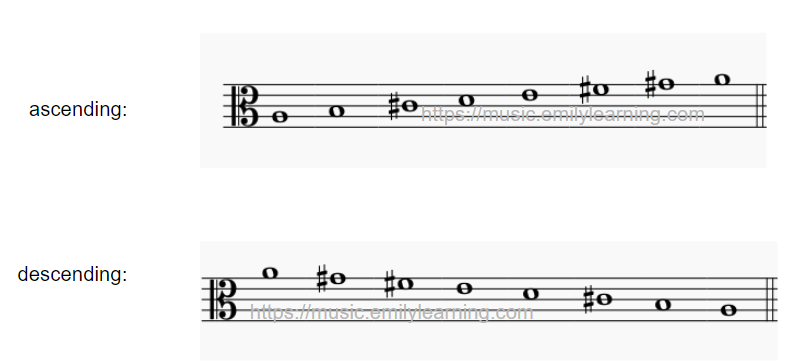A Major Scale it starts and ends with A. The relative minor of A Major is F# minor. Both of these keys have F#, C# and G#.
A Major Key Signature
Here’s the key signature for A Major – F#, C# and G#.




Notes in the Scale of A Major
When we play a scale, we usually start off with an ascending scale (the notes get higher), followed by descending scale (the notes get lower).
Ascending scale of A Major: A, B, C#, D, E, F#, G#, A
Descending scale of A Major: A, G#, F#, E#, D, C#, B, A
Degrees of the Scale
Degrees of the scale refers to the number we assign to each note of a scale. When we are assigning degrees of a scale, we look at the scale in ascending order. Here are the notes for the various degrees of the A Major scale:
1st degree: A
2nd degree: B
3rd degree: C#
4th degree: D
5th degree: E
6th degree: F#
7th degree: G#
Technical Names of Notes in A Major
Instead of using the degree of the scale, we can also use technical names of notes.
tonic – A
supertonic – B
mediant – C#
subdominant – D
dominant – E
submediant – F#
leading note – G#
Semitones and Tones
In all major scales, they follow this:
| Pairs of notes | Tone or semitone apart? |
| 1st -> 2nd | tone |
| 2nd -> 3rd | tone |
| 3rd -> 4th | semitone |
| 4th -> 5th | tone |
| 5th -> 6th | tone |
| 6th -> 7th | tone |
| 7th -> 8th | semitone |
Most adjacent pairs of notes in the major scale are a tone apart, except for the 3rd to 4th note, and the 7th to the 8th note. This doesn’t apply just to A Major scale, but for ALL major scales. By knowing the distance between the notes in a Major scale, we can form any major scale even if we do not know its key signature.
In this case, the semitones are found here:
- From C# to D (3rd to 4th note)
- From G# to A (7th to 8th note)
A Major Scale on different clefs.
Here’s how the A Major scales look like in treble clef (without key signature). I’ve also included the fingerings:

Here’s how the A Major scales look like in bass clef (without key signature). I’ve also included the fingerings:

Here’s how the A Major scales look like in alto clef.

Here’s how the A Major scales look like in tenor clef (without key signature).

How to play the A Major scale on the piano
The fingerings for the right hand part of the A Major scale are:
A -1/5 (Use 5th finger for the highest note of the scale)
B- 2
C#- 3
D -1
E – 2
F#- 3
G# – 4
The fingerings for the left hand part of the E Major scale are:
A -1/5 (Use the 5th finger for the lowest note, the rest should be played with the 1st finger or thumb)
B- 4
C#- 3
D -2
E – 1
F# – 3
G# – 2
